|
|
| Machinery |
Minimum Size |
Average Production |
Remarks on Average Production |
| Grader with scarifying teeth |
CAT 14 G |
6-8 hrs per day |
Hard / heavy ripping by grader scarifier may
reduce production. Spreading from dumped stockpiles will improve
production |
| Water Tanker with pressure pump to provide
even spraying |
6,000 to 8,000 liters |
1/2 day |
Must have pump to fill / discharge water
quickly from the tanker. If water source is far from site, water supply to
layer will be slow. If material is very dry or clay much water loads will
be required. Moisture content of layer or dumped material will affect
number of tanker loads required. |
| Pneumatic tired roller |
10 - 12 T |
1/2 day |
This is a good roller to compact around stone
particles and so give even compaction of layer. Use immediately shaping
starts compacting from the bottom of layer to top. |
| Vibratory / flat 3 wheel roller |
10 - 12 T |
1/2 day |
Rollers required to get required specified
density compaction to start early from bottom to top of layer |
| Tamping / pad foot roller |
10 - 12 T |
1/2 day, if required |
If clay material is being used for lower
layer this roller should be used compacting from bottom to top of layer |
| Rotovator or Tractor with disc harrow |
|
1/2 day, if required |
This plant can be used to break up clods of
soil and to provide |
Construction Procedures
Assuming that the specified layer (15 cm) material is either in place on the
road (therefore requiring ripping or scarifying for mixing to take place) or
sufficient material brought from borrow pits and dumped alongside road edge for
15 cm layer to be cut in from dumped piles by grader when mixing.
Average daily production is about 300 to 750 meter length x 7-9
meter width x 15 cm thickness or about 1.2 km - 1.5 km / week. (i.e., 2,000 -
5,000m2 / day or 10,000 - 25,000 m2/week).
1.
Clearing the road of any vegetation and organic topsoil to ensure
construction is possible within the boundaries.
2.
Sides have to be excavated for new roads and cleared for existing roads.
3.
Shape the road to ensure at least 4-6% side slope for drainage.
4.
Layer thickness must be in multiples of 15cm, and where more than one layer
is to be treated, windrow the top layer to expose the lower layer.
5.
Imported material, where recommended, must be placed and spread.
6.
The layer material must be scarified with a grader to loosen and break down
lumps or clods as much as possible. Where necessary a rotorvator or disc
harrow must be used to help loosen and break down lumps.
7.
Determine the required quantity of CBR PLUS needed to treat the area of road
open and also determine the quantity of water required to raise the moisture
content of the soil to 1% above OMC.
8.
Equally distribute the quantity of CBR PLUS into the water tankers before
the mixture is sprayed evenly over the open area. The CBR PLUS is fully
soluble in water and must be added to tanker only after (not before) the
tanker has the full or required quantity of water in it.
9.
Mixing of the water and CBR PLUS in the tanker can be facilitated by
circulating the water with the pump, or where no pump is fitted, to drive
the tanker backwards and forwards over a short distance.
10.
The diluted mixture is sprayed onto the layer while being processed by
grader, disc harrow, or rotorvator until the layer of soil has been well
mixed.
11.
After re-shaping the road, compaction can begin with a roller. Where heavy
clays are present, compaction must be by pad foot and in layers of 5-7cm,
from the bottom up.
12.
Final shaping with the grader is followed by final rolling, usually with a
peumatic roller.
Opening to Traffic
During construction and immediately after final compaction, the roadway can
be opened to traffic. Any deformation should be corrected by grading and
compaction before the material dries out fully.
Curing
After the stabilized layer has been compacted to the required density and
brought to the required lines and grades in accordance with the typical
cross section, the completed section should be cured. This curing is
accomplished by the daily application of water with the water tanker,
depending upon the climate and the depth of treatment, usually for seven to
ten days after completion date.
During this period traffic may use the stabilized road.
Please note that during this period small quantities of CBR PLUS remain on
the surface which may create a slippery face in some instances during
rainfall and depending upon the type of soil stabilized. This slipperiness
is normal and usually disappears after the curing period or a few
rainstorms.
Maintenance
One of the major advantages of CBR PLUS over other soil stabilizers is the
fact that CBR PLUS can be repaired.
CBR PLUS is not cementitious. Normal wear of the gravel road surface i.e.,
gravel loss, rutting and dust can be expected. To repair the road to its
original state, wet the road surface thoroughly and follow normal grader
blade maintenance procedures. Provided no untreated material is brought into
the road from the sides during grading, the traffic will re-compact the road
again without re-treatment with CBR PLUS.
If untreated material from the road side is brought onto the road during
maintenance grading, the surface should be treated with a very small dosage
of CBR PLUS.
Surfacing
If surfacing of the treated road surface is required, the field moisture
content of the stabilized layer must be allowed to stabilize between 50 to
60 % of optimum moisture content. Depending on the soil type, climate and
temperature (including rainfall during this curing period), this may take
between 6 to 12 weeks or longer.
Life span of CBR PLUS Stabilized Layer
The change in the treated clay is permanent and will not reverse itself due
to leaching. In theory therefore, the CBR PLUS treated road should last
forever if the construction procedure and instructions are followed
properly, but in reality special variability of subsoil and drainage is
expected. Normal wear and tear prevails and the roads built with CBR PLUS
stabilized soil will require some maintenance.
The resultant road should however present a significantly improved
rideability, particularly in wet weather, and substantial reductions in
maintenance.
There are some CBR PLUS stabilized roads in existence, which have been used
continuously for over twenty years.
|

Scarification
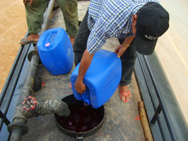
Placing CON-AID
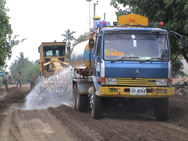
Spraying of CON-AID
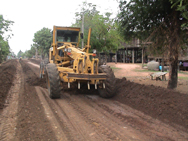
Mixing CON-AID
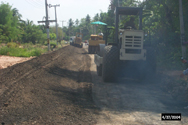
Reshaping and Compacting
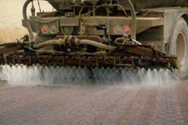
Curing
|
|
|